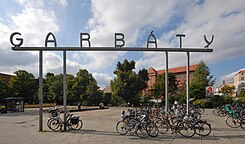Garbáty Square
| Garbáty Square | |
|---|---|
| Place in Berlin | |
 Garbáty memorial ribbon in the square; in the background Elizabeth Shaw Elementary School |
|
| Basic data | |
| place | Berlin |
| District | Pankow |
| Created | 20th century (nameless) |
| Newly designed | 21st century |
| Confluent streets | Florastraße (west / south), Berliner Straße (east) |
| Buildings | Monument (lettering) and a base plate for the namesake |
| use | |
| User groups | Pedestrians , local traffic (taxi, public bus) |
| Technical specifications | |
| Square area | 6500 m² |
The Garbátyplatz is located in the Berlin district of Pankow , district Pankow . It is the forecourt to the Pankow S-Bahn station along Florastraße, which was previously unnamed.
History and design of the square
From 1930 to 1944 there was a depot for the Berlin street cleaning companies on the corner of Florastraße / Berliner Straße 14 and in the neighborhood (house numbers 11-13) several shops (groceries, fur shop, optician, also a funeral home), the post office with a director's apartment in it (Number 12) and a restaurant (number 13). After 1945 a free area was created due to the destruction of the war. This area north of the S- Bahn line at Berlin-Pankow station was kept free for the extension of the underground to Nordend , which had been planned since the 1970s . It stayed that way even after reunification .
The place that was planted with some trees, but provided mainly with paving slabs, was on 16 September 2000 in honor of the Jewish cigarette n fabrikanten Josef Garbáty the name Garbátyplatz awarded. The naming ceremony was part of the opening ceremony for the Pankow underground station. The district office honored the work of the Garbáty family for the then Pankow district - both as an employer in the adjacent Berliner Straße and the extensive social commitment. The place designation became officially binding on January 23, 2001.
In 2008, the Liegenschaftsfonds Berlin sold the space to the Merz company from Baden-Württemberg . As a temporary solution until the completion of a planned building as the northern boundary of the square, a twelve-meter-long overseas container was set up on the square in coordination between the Pankow District Office and the Pankow Museum and used for the exhibition “Schaustelle Berliner Straße | History-Present-Future”. This exhibition accompanied the construction work, among other things, visitors were given an insight into the chronology of Berliner Straße , information about the Florastraße redevelopment area and the plans for further new buildings. The container was dismantled in winter 2011/2012.
Edge development
The three-part service center, which was completed by Merz Objektbau between April 2011 and September 2012 on the north side of the square by the company Merz Objektbau, has three floors with a usable area of 5700 square meters. The middle section is a 30 meter long bridge over the subway entrance. The house is rented by doctors, retailers, an Edeka store and a drugstore. The building block hides the previously visible gable wall of a residential building on Berliner Straße. The architectural design comes from Merz Architekten from Aalen , the construction costs are given at around 20 million euros. No sooner had the scaffolding around the building been removed than complaints from residents, users of the square and supporters of the SPD because its facade, made of dark natural stone slabs, did not fit into the surroundings. The district office had approved a facade in a "much lighter shade with differently colored facade fields" in accordance with the building draft, the bridge component should even be white. At first it was thought to impose a fine on the investors and to issue a dismantling order. Because the non-profit foundation named after the entrepreneur Karl Schlecht had acquired the building complex in April 2013, this did not happen. The new owners were interested in an amicable solution, which now seems to have been found: reflective metal jewelry should cover the dark panels and contribute to an adapted appearance. Construction work can begin once the district office has approved the redesign of the facade. As early as June 2013, the foundation will upgrade the square. The monument to Garbáty will be put back in its place and additional parking spaces for around 1000 bicycles a day will be created.
The station building (Florastraße 52) on the southern edge of the square was inaugurated in 1916 and is a listed building .
Web links
- Garbáty Square. In: Street name lexicon of the Luisenstädtischer Bildungsverein (near Kaupert )
Individual evidence
- ^ Berliner Strasse . In: Berliner Adreßbuch , 1940, part 4, Pankow, p. 2421.
- ↑ 2000. Day after day . In: Chronicle Berlin of the Luisenstädtischer Bildungsverein
- ↑ Pankow. Innovative • creative • active . 2011 edition, aperçu * Verlagsgesellschaft mbH in cooperation with the Pankow district office of Berlin (economic development); therein: Construction site with exhibition site , p. 64
- ↑ Start of construction on Garbatyplatz on merzobjekt.de; Retrieved May 24, 2013
- ↑ Sebastian Höhn: The dark facade has to go . In: Berliner Zeitung , January 3, 2013.
- ↑ Karl-Schlecht-Stiftung ( Memento of the original from June 25, 2013 in the Internet Archive ) Info: The archive link was inserted automatically and has not yet been checked. Please check the original and archive link according to the instructions and then remove this notice. Retrieved May 24, 2013
- ↑ Stefan Strauss: Glitter on Garbátyplatz. The dispute over the dark new building is over. Metal jewelry should now brighten the facade . In: Berliner Zeitung , May 24, 2013, p. 18
- ↑ Architectural ensemble of S-Bahn station Pankow with reception building, residential and administration building, staircase and platform, around 1908–1916 by Ernst Schwartz and Karl Cornelius, Florastraße 52
Coordinates: 52 ° 34 ′ 3 ″ N , 13 ° 24 ′ 41 ″ E